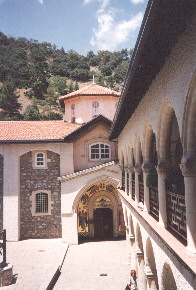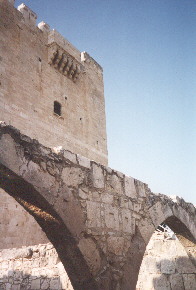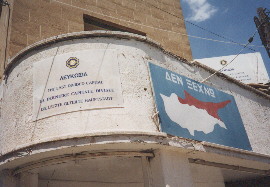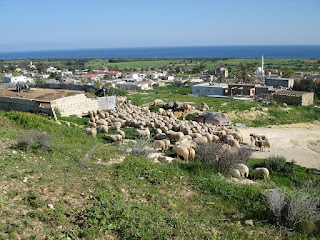Cyprus (Κύπρος, Kibris) is the
third-largest island in the Mediterranean
Sea and has been continuously inhabited for thousands of years. It
has an
estimated population of around 1,134,000 (2011), of whom some 80 percent
are Greek-speaking Orthodox Christians and some 20 percent
Turkish-speaking
Sunni Muslims. The remaining population includes small numbers of
Syriac-speaking
Maronites,
Armenians and so-called Latins. Since 1974 the island has been divided
between the two
ethnic communities, with Turks concentrated in the north and Greeks in
the south.
Ancient times
Cyprus's
beginnings
lie deep within prehistory. Human habitation began at least 7000 BC, as
people apparently arrived from the nearby Asian mainland. It has
recently been discovered that these early Cypriots were the first to domesticate the cat, even before the Egyptians. (This is somewhat
ironic, since in the Greek-speaking world nowadays cats are rarely kept
as pets.) The island eventually became known for
its copper, the presence of which gives the soil a distinctive reddish
cast and the food grown in it a delicious flavour. The very
name of the island may either have been bequeathed
to the metal or have taken its name from it. Greek presence in Cyprus
began in the second millennium BC and has continued to the present.
Early in the first millennium Phoenician settlement was established in
the eastern part of Cyprus, centred especially around the ancient city
of
Kition. According to local mythology, the goddess Aphrodite rose to
life from the sea off the coast of Paphos. For this reason Cyprus
is still to this day known popularly as
νησί της
Αφροδίτης,
the
island of Aphrodite.
Although Cyprus was occupied
by several local
kingdoms, as the age of empires dawned the island inevitably found
itself within the shifting spheres of influence of the surrounding
political powers, including the Assyrians, the Egyptians, the Persians,
the Hellenistic successors of Alexander the Great and, finally, the
Romans. The remnants of the ancient cities of this era can be found at Salamis,
Kition, Amathous, Kourion and Paphos. The ruins of Kourion,
near
present-day Limassol,
can be seen at left. Cyprus was known as Alasia in the ancient records
of the time. In the Old Testament, Cypriots are generally
referred
to as Kittim, whose etymological relationship to Kition is
evident. Brief periods of independence for the Cypriot kingdoms
were usually ended by their reincorporation into the dominions of the
age's imperial powers.
The
Roman and
Byzantine eras and
the rise of Christianity
Cyprus came under Roman rule
in 30 BC. Around
AD 45 the apostles Paul and Barnabas evangelized the island, as
recounted in Acts 13. As part of a larger Jewish community,
Barnabas himself had been born in the island. Barnabas and Mark
revisited
Cyprus in 47. Eventually the island would come to be very largely won
to the Christian faith. Tradition has it that Lazarus, whom Jesus
raised from the dead shortly before his own crucifixion, became the
bishop of Kition and died there a second time. The Church of
St. Lazarus
(right) in
Larnaca claims to house his remains. In one fashion or another, Roman
rule continued until the twelfth century, although most of this
period is usually labelled Byzantine, after the ancient name of the new
imperial capital, Constantinople.
After conversion of the Empire to
Christianity in the fourth century,
the Church of Cyprus attained a special status within the larger
church. In 431 the Council of Ephesus granted it independence from the
patriarchal see of Antioch, a decision subsequently ratified in 488 by
the Emperor Zeno. The Church of Cyprus retains this status to the
present day and is headed by its own elected archbishop.

Frankish
and
Venetian rule

The Lusignan rulers of Cyprus
were mostly undistinguished
and were, in any event, a foreign presence in the island. The
Latin church was favoured, and the Orthodox Church was forcibly brought
under submission to Rome. As a result of a marriage between the
last Lusignan king, James II, and Caterina
Cornaro, Cyprus came under
Venetian
rule in 1489. The Venetian Republic had a maritime
empire encompassing much of the Dalmatian coast of the Adriatic, Crete
and Cyprus itself. Among other things, the Venetians rebuilt the walls of
Famagusta, which bear the symbol of Venice: the famous Lion of
St. Mark
(left). Cyprus suffered from relative neglect under the
Venetians. In 1571, the same year that the west won a decisive
naval victory against the Ottoman Turks at Lepanto, the Turks laid
siege
to Famagusta, successfully taking the city and plunging Cyprus
into
just over three centuries of Muslim occupation.
Ottoman
rule
The Turkish
conquest of Cyprus was not an unmitigated
disaster, and
many Greek Orthodox subjects, who had seen their church suppressed
under the "Latins," actually welcomed Ottoman rule. Indeed the
Ottoman authorities were comparatively tolerant of religious minorities
in their empire, and they moved to rehabilitate the Orthodox
Church. Moreover, they went so far as to grant the island's
prelate genuine political authority over the Sultan's christian
subjects. Thus began the peculiar institution of the ethnarchy,
which reached its apogee in the twentieth century in the person of
Archbishop Makarios III, the first president of independent Cyprus
after 1960.
However,
for the most part, once the dust had settled, Ottoman rule
became as onerous as Lusignan and Venetian rule had been. The
population of Cyprus declined during the Turkish period, as many people
left the island. There were occasional rebellions by both christian and
muslim subjects in Cyprus against their rulers. The Turkish legacy
contributed few visible landmarks, one of which is an eighteenth-century
aqueduct in Larnaca (above right).
After 1683 the Ottoman
Empire went into a long, slow decline, thereby opening the notorious
Eastern Question, which would bedevil western policy-makers throughout
the subsequent centuries until the Great War of 1914-18. In 1877 Russia
came perillously close to conquering Constantinople outright and
imposed the abortive Treaty of San Stefano on the Sultan. The western
powers intervened and propped up the Ottoman Empire for another
generation and a half. As a price for its own protection of the Empire,
the United Kingdom received Cyprus in 1878.
The
British
colonial era
For
the first nearly half-century of British
rule, the island was effectively under British administration but
its population remained nominal subjects of the Ottoman Sultan. Because
Britain had a
philhellenic reputation, many of the island's christian population
assumed that she would eventually cede it to the Greek kingdom, as she
had the Ionian Islands in 1864. From the outset the British high
commissioners made the fateful decision to allow the importation of
school textbooks from Greece itself, thereby inadvertently imparting to
Cyprus'
christian youth a sense of being part of a Greek irredenta. Thus began
a lengthy campaign for enosis,
or union of the island with Greece. At the outbreak of the Great War,
which found Britain and Turkey on opposite sides,
Britain annexed Cyprus outright, a move subsequently confirmed by
Turkey in the Treaty of Lausanne in 1923. Cyprus became a Crown colony
in 1925,
a status which continued until 1960. In 1931 a pro-enosis uprising
took place, after
which the colonial government was suspended and direct rule imposed. In
its first fifty years British rule was scarcely less onerous than
Ottoman, with the latter's high taxes maintained until 1927 to service
an Ottoman debt. Thus Cyprus remained economically backward
through that time.
After
the Labour Party came to power in Britain, Lord Winster, the
colonial Governor of Cyprus, offered the island a constitution
providing for a full measure of self-government but leaving its
external status unchanged. With the encouragement of the Church, which
was imbued with the Greek nationalist vision of the nineteenth-century Μεγάλη
Ιδέα, or Great Idea, the people
of Cyprus unwisely rejected
this. It is
difficult to determine the actual support for enosis among the
ethnic
Greek population at this time, but a Church-sponsored plebiscite in
1950 showed 96 percent in favour. Relations between Britain and the
Greek Cypriot population soured during the 1950s, with a guerrilla war
breaking out in 1955. The principal instigator of hostilities was the
National Organization of Cypriot Fighters, known by its Greek acronym,
EOKA. Understandably, the ethnic Turkish population opposed the cession
of Cyprus to Greece and sought either to maintain the status quo or to
partition the island between Athens and Ankara.
Once
Britain had accepted that its rule over Cyprus was at an
end, a compromise solution was reached whereby the island would become
an independent republic within the Commonwealth, with Britain retaining
sovereign military bases at Akrotiri and Dhekelia.
Independence,
continued troubles and partition
A
conditional independence was granted to Cyprus in 1960 under terms of
the London/Zürich Agreement and under a new, exceedingly
lengthy constitutional
document that was negotiated by the UK, Greece and
Turkey but had little input from Cypriots themselves of either ethnic
community.
Greek Cypriots elected as their first president Archbishop Makarios
III, in a latter-day manifestation
of the Ottoman ethnarchy.
With little if any basis in domestic traditions of intercommunal
accommodation,
the new constitution failed after only three years. In 1963 the first
of the post-independence
episodes of intercommunal strife broke out, when Makarios attempted to
streamline
the constitution in exchange for minority guarantees. The Turkish
Cypriot ministers would have
none of it and left
the government. With the encouragement of their élites,
Turkish
Cypriots began to segregate themselves into enclaves in a dark
precursor
to the island's partition. United
Nations peacekeeping troops were sent
to keep
the two communities apart—a presence that is now nearly six
decades old.



Cyprus
today


The
government of the Cyprus Republic is a truncated
one relative to
what was established in the 1960 Constitution. The head of
state and government is the President.
A Council of Ministers is appointed by the
President and, nominally, the Vice-President.
Although the Vice-President's office was supposed to be occupied by a
Turkish Cypriot, it has in fact been vacant since 1963. There is a
unicameral House
of Representatives
(Βουλή
των
Αντιπροσώπων),
whose
seats were to
have been segregated and reserved for the two ethnic communities. Once
again, the
Turkish Cypriot seats are vacant. Deputies serve for five-year terms,
as does the President of the Republic.
The
TRNC political system is a parliamentary one,
seemingly modelled on that of Turkey prior to 2017, with separate offices of
President and Prime
Minister, the latter of whom appoints a Cabinet. The legislature is
known as the Assembly of the Republic, or the Cumhuriyet Meclisi.
Most
proposals to reunify the island envision a
territorial federal framework with
a modification of the boundary separating the two sides, return of
property or
appropriate compensation for its loss, and freedom of movement.
Culture

The
music of Cyprus is rather distinctive, although
it shares features with other music of the region, especially that of
Greece and Turkey. In the folk tradition, there is a pronounced
affinity for asymmetrical rhythms, especially 5/4 or 5/8 time, in
addition to the 7/8 time signature found elsewhere in
the Greek-speaking world. A quite good webpage is devoted to Cyprus
music,
including ancient Byzantine kalanda
(κάλαντα) and
the more recent
compositions of Michalis
Violaris and others. In my considered opinion, the best
recording
of Cypriot music is Chants
épiques
et populaires de Chypre, recorded by the
Ensemble Cypriote
de Musique ancienne and published under the Arion label in France in
1982.

Though distinctive in some
elements, Cypriot
cuisine
shares much with those of the surrounding region. Anyone who has eaten
at Greek
or middle eastern restaurants will recognize much of the fare that
nourishes the people of Cyprus. Shown at left are three typical foods. Koupepkia
(Κουπέπκια)
are
stuffed grape vine leaves known elsewhere in the Greek-speaking world
as Dolmadhes
(Ντολμάδες),
from the Turkish verb dolmak,
meaning "to fill, to stuff." Moving clockwise around the plate are four
slices of halloumi
(χαλλούμι, hellim
in
Turkish), a delicious cheese unique to the island, made of sheep and
goat milk, packed in its own juices and sprinkled with mint. Its
unusual physical properties enable it to be grilled without melting, as
most cheeses would if subjected to similar treatment. Then, of
course, come the ubiquitous olives,
as
shown above. As in most cuisines
of the region, meat is reserved for special occasions, such as lamb for
Πάσχα. Everyday meals include
vegetables, legumes and grains, with
olive oil a perennial staple. Extra virgin olive oil comes from the
first pressing of the olives and is used for salads, bread, and
drizzling over boiled greens. Lower grades of olive oil come from later
pressings and are used for cooking. One of the more typical dishes in
the home (but not the restaurant) is moujendra
(μουτζιέντρα),
made
of at least lentils and rice, and sometimes additional ingredients as
well.
Not
surprisingly, Cyprus is known for its wines.
Already mentioned above is Commandaria,
reputedly the oldest wine in the world. Indeed some think that wine was
invented here. The southern city of Limassol sponsors an annual winefestival
in
the late summer. Its slogan is well known in the island:
Πίννε
κρασίν
νάσιης
ζωήν ("Drink wine to have
life" in
Τζιυπριώτικα).
When my wife
and I were in a Cyprus café in 1995, we were served an
excellent
dry red wine in an unmarked bottle. After inquiring as to its identity,
the
waiter shrugged his shoulder and said it was "village wine" from
the Troodos Mountains. Nothing fancy, but certainly amongst the best
wines we've ever drunk.
The
languages of Cyprus are Greek and Turkish,
although the tiny Maronite population, traditionally found in the
northern village of Kormakiti, speaks Syriac/Aramaic in addition to
Greek. In standard demotic Greek the Cypriot
dialect is
known as
Κυπριακά.
In the island it is
known as
Τζιυπριώτικα
(pronounced Tcheep-ree-O-tee-ka).
The most
recognizable feature of the Cypriot dialect is that, where the letter
κ
(kappa) occurs in standard Greek, it is softened to a
<tch> or
<dj> sound if it precedes the letters ι,
υ, η,
ε and the
homophonous digraphs, ει, οι
and
αι. In this respect the development of
Cypriot Greek mirrors a similar shift in the romance languages from
Latin to Italian and Romanian. Whether this was an indigenous natural
development
or occurred under the influence of Italian during the Venetian era is
uncertain. Because it is found elsewhere in the Greek islands—
most
notably Crete and even as
far west
as Kerkira (Corfu)—and because many of these same islands
were
controlled
by Venice or Genoa, either explanation is possible. A second
characteristic feature of
Τζιυπριώτικα
sees words ending in -ια
preceded by a <k> sound. For example, the word
τραγούδια
(songs)
becomes
τραούδκια
or
τραούθκια,
as in
τζιυπριώτικα
τραούδκια
(Cypriot
songs). Similarly, τα
μάτια (the eyes)
becomes τα
μάθκια. Third,
whereas the final letter ν has generally been dropped
from neuter nouns in standard modern Greek, it has been retained in the
Cypriot dialect, as in το
παιδίν
(the boy). In this respect the Cypriot
dialect retains an archaic flavour relative to the standard language.
Other peculiarities:
English
|
Standard Greek
|
Cypriot Greek
|
| I and you shall
go to Cyprus. |
Εγώ
και εσύ
θα
πάμε στην
Κύπρο. |
Εγιώνι
τζι'εσούνι
έννα
πάμεν
στην
Τζιύπρον. |
| How are you? |
Τι
κάνεις; |
Ίντα
μπου
κάμνεις; |
My father comes
from the house.
|
Ο
μπαμπάς
μου
έρχεται
απ' το
σπίτι.
|
Ο
τζιύρης
μου
έρκεται
'πο το
σπίτιν.
|
brothers and
sisters
|
αδέλφια |
αδέρκια |
There are many other differences as well, which
space does not allow us
to cover here. Had political history developed somewhat differently, it
is
possible that
Τζιυπριώτικα
might have come to be viewed as a distinct
language within a larger Hellenic family.
Selected
bibliography
Attalides, Michael. Cyprus.
New
York: St. Martin's Press, 1979.
Beaudoin, Mondry. Étude
de
Dialecte chypriote moderne et médiéval.
Paris:
Librairie des Écoles françaises
d'Athènes et de
Rome, 1884.
Durrell, Lawrence. Bitter Lemons.
London: Faber & Faber, 1959.
Foley, Charles. Legacy of
Strife:
Cyprus from rebellion to civil war. Harmondsworth, UK:
Penguin,
1962, 1964.
Georgiades, Cleanthis P. History of
Cyprus.
Engomi: Demetrakis Christophorou, 2nd English edition, nd (1993?).
Hitchens, Christopher. Hostage
to History: Cyprus from the Ottomans to Kissinger. London:
Verso, 1997.
Hunt, Sir David, ed. Footprints in
Cyprus:
an illustrated history. London: Trigraph, 1990.
Joseph, Joseph S. Cyprus:
Ethnic Conflict
and International Politics. Houndmills: Macmillan, 1997.
Kyriakides, Stanley. Cyprus:
Constitutionalism and Crisis Government. Philadelphia:
University of Pennsylvania Press, 1968.
Lanitis, George. Νάσος
τας
Αφροδίτας:
Cyprus: Island of Aphrodite. Nicosia: Phædros
Editions,
1967.
Mallinson, William. Cyprus: A
Modern History.
I. B. Tauris, 2005.
Morgan, Tabitha. Sweet and Bitter Island: A History of the British in Cyprus. London, New York: I. B. Tauris, 2010.
Mourdjis, Marios. The Cypriots
at Table.
C.A.L. Graphics, nd (late 1970s?).
Newton, Brian. Cypriot
Greek: its
phonology and inflections. The Hague, Paris: Mouton, 1972.
Oberling, Pierre. The Road to
Bellapais:
The Turkish Cypriot exodus to northern Cyprus. East
European
Monographs, 1981.
Polyviou, Polyvios G. Cyprus: The
Tragedy and
the Challenge. England: John Swain & Son Ltd.,
1975.
________. Cyprus:
Conflict and
Negotiation, 1960-1980. London: Duckworth, 1980.
Stavrou, Patroclos. Cyprus: The
Sweet Land.
Nicosia: Achilles Ghinis, 1971.
Stern, Laurence. The Wrong
Horse.
New York: Times Books, 1977.
Thubron, Colin. Journey into
Cyprus.
Harmondsworth: Penguin, 1986, originally published 1975.
Toy, Barbara. Rendezvous in
Cyprus.
London: John Murray, 1970.
Text and photographs © David
T. Koyzis, 2006. All rights reserved.














No comments:
Post a Comment